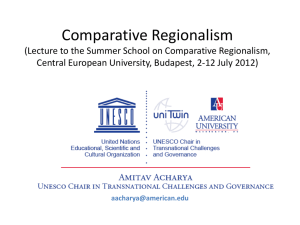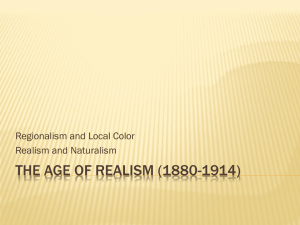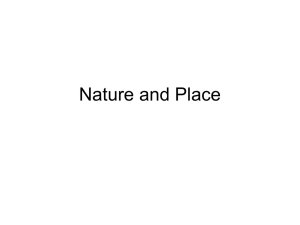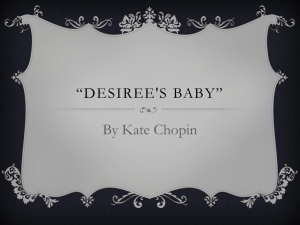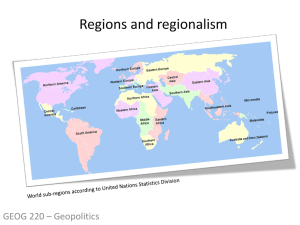Syllabus - Department of International Relations
advertisement
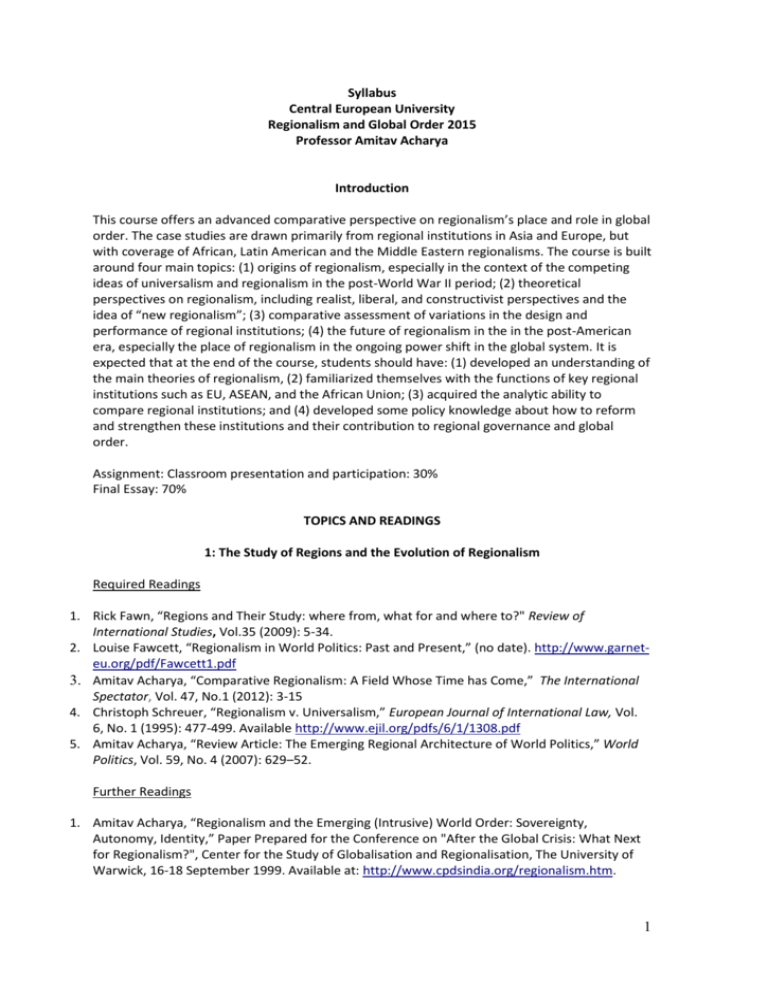
Syllabus Central European University Regionalism and Global Order 2015 Professor Amitav Acharya Introduction This course offers an advanced comparative perspective on regionalism’s place and role in global order. The case studies are drawn primarily from regional institutions in Asia and Europe, but with coverage of African, Latin American and the Middle Eastern regionalisms. The course is built around four main topics: (1) origins of regionalism, especially in the context of the competing ideas of universalism and regionalism in the post-World War II period; (2) theoretical perspectives on regionalism, including realist, liberal, and constructivist perspectives and the idea of “new regionalism”; (3) comparative assessment of variations in the design and performance of regional institutions; (4) the future of regionalism in the in the post-American era, especially the place of regionalism in the ongoing power shift in the global system. It is expected that at the end of the course, students should have: (1) developed an understanding of the main theories of regionalism, (2) familiarized themselves with the functions of key regional institutions such as EU, ASEAN, and the African Union; (3) acquired the analytic ability to compare regional institutions; and (4) developed some policy knowledge about how to reform and strengthen these institutions and their contribution to regional governance and global order. Assignment: Classroom presentation and participation: 30% Final Essay: 70% TOPICS AND READINGS 1: The Study of Regions and the Evolution of Regionalism Required Readings 1. Rick Fawn, “Regions and Their Study: where from, what for and where to?" Review of International Studies, Vol.35 (2009): 5-34. 2. Louise Fawcett, “Regionalism in World Politics: Past and Present,” (no date). http://www.garneteu.org/pdf/Fawcett1.pdf 3. Amitav Acharya, “Comparative Regionalism: A Field Whose Time has Come,” The International Spectator, Vol. 47, No.1 (2012): 3-15 4. Christoph Schreuer, “Regionalism v. Universalism,” European Journal of International Law, Vol. 6, No. 1 (1995): 477-499. Available http://www.ejil.org/pdfs/6/1/1308.pdf 5. Amitav Acharya, “Review Article: The Emerging Regional Architecture of World Politics,” World Politics, Vol. 59, No. 4 (2007): 629–52. Further Readings 1. Amitav Acharya, “Regionalism and the Emerging (Intrusive) World Order: Sovereignty, Autonomy, Identity,” Paper Prepared for the Conference on "After the Global Crisis: What Next for Regionalism?", Center for the Study of Globalisation and Regionalisation, The University of Warwick, 16-18 September 1999. Available at: http://www.cpdsindia.org/regionalism.htm. 1 2. Alberta Sbragia, "Review Article: Comparative Regionalism: What might it be?" Journal of Common Market Studies, Vol.46 (2008): 29-49. 3. Amitav Acharya and Alastair Iain Johnston, eds., Crafting Cooperation: Regional International Institutions in International Politics (Cambridge: Cambridge University Press 2007): 4. Richard Falk, “Regionalism and World Order after the Cold War,” Australian Journal of International Affairs, Vol. 49, No.1 (May 1995): 1-15. 5. Stephen Aris and Andreas Wenger, eds. Regional Organisations and Security: Conceptions and Practices (New York: Routledge, 2014) 6. Francis Wilcox, “Regionalism and the United Nations,” International Organization, Vol. 19 No.3, (1965): 789-811. 7. Baldwin, Richard, "The Causes of Regionalism," The World Economy, Vol. 20, No. 7 (1997): pp 865-888 8. Emil Joseph Kirchner and Roberto Domínguez, eds., The Security Governance of Regional Organizations (New York: Routledge, 2011). 9. Mansfi eld, Edward D. and Helen V. Milner, ‘The New Wave of Regionalism’, International Organization Vol. 53, No. 3 (1999): pp. 602–608; 10. Peter J., Katzenstein, A World of Regions: Asia and Europe in the American Imperium (Cornell University Press, 2005). 11. Paul, T.V., ed. International Relations Theory and Regional Transformation (Cambridge: Cambridge University Press, 2012). 12. Rodrigo Tavares, Regional Security: The Capacity of International Organizations (New York: Routledge, 2010). 13. Raimo Vyrynen, “Regionalism: Old and New,” International Studies Review, Vol 5 (2003) pp. 25– 51 14. Edward D. Mansfield and Etel Solingen, “Regionalism,” Annual Review of Political Science, Vol. 13: 145-163. 2: Theories of Regionalism Required Readings 1. Andrew Hurrell, “Explaining the Resurgence of Regionalism in World Politics,” Review of International Studies, vol. 21, no. 4 (October 1995), 331-358. 2. Donald J. Puchala, “The Integration Theorists and the Study of International Relations.” In Charles W. Kegley, Jr. and Eugene R. Wittkopf, eds., In The Global Agenda: Issues and Perspectives (New York: Random House 1984). 3. Amitav Acharya, “Ideas, Norms and Regional Orders,” in T.V. Paul, ed., International Relations Theory and Regional Transformation (Cambridge: Cambridge University Press, 2012),pp.183-209. 4. Sita Ranchod-Nilsson, “Regional Worlds: Transforming Pedagogy in Area Studies and International Studies”, Chicago: University of Chicago (Fall 2000). http://regionalworlds.uchicago.edu/transformingpedagogy.pdf 5. Bjorn Hettne and Andras Inotai, The New Regionalism: Implications for Global Development and International Security (Helsinki: UNU World Institute for Development Economics Research, 1994). www.foresightfordevelopment.org/sobipro/download-file/46-769/54 6. Amitav Acharya, “Regionalism Beyond EUcentrism,” Paper Prepared for the Oxford Handbook on Comparative Regionalism (November 2014). Further Readings 1. T.V. Paul, ed. International Relations Theory and Regional Transformation (Cambridge: Cambridge University Press, 2012). 2 2. Joseph M. Grieco, Realism and Regionalism: American Power and German and Japanese Institutional Strategies During and After the Cold War, in Ethan Kapstein and Michael Mastanduno, Unipolar Politics: Realism and State Strategies After the Cold War (New York: Columbia University Press, 1999). http://poli.vub.ac.be/publi/orderbooks/myth/08Grieco.pdf 3. Ernst B. Haas, "Turbulent Fields and the Theory of Regional Integration," International Organization 30 (Spring 1976): 173-212. 4. Thomas Christiansen, Knud Erik Jorgensen and Antje Wiener. 2001. “Introduction”, in Christiansen, Jorgensen and Wiener, eds., The Social Construction of Europe. (London: Sage Publications, 2001). 5. Andrew Moravcsik, "Constructivism and European Integration: A Critique," in Christiansen, Jorgensen and Wiener, eds. The Social Construction of Europe (London: Sage Publications, 2001). 6. Ernst B. Haas, “International Integration: The European and the Universal process,” International Organization 15 (1961): 366-392. 7. Amitav Acharya, Constructing a Security Community in Southeast Asia, 3rd edn (London and New York: Routledge, 2014), Chapter 1 (“Constructing Security Communities”) 8. Charles A. Kupchan, How Enemies Become Friends: The Sources of Stable Peace (Princeton, N.J.: Princeton University Press, 2010) 3: European Regionalism: EU, NATO and OSCE Required Readings 1. Thomas Christiansen, Knud Erik Jorgensen and Antje Wiener, “Introduction,” in Christiansen, Jorgensen and Wiener, eds., The Social Construction of Europe (Sage 2001). 2. Ben Rosamond, “Conceptualising the EU model of governance in world politics,” (University of Warwick 2005). http://wrap.warwick.ac.uk/1098/1/WRAP_Rosamond_9570885-150709rosamond_efar_05.pdf 3. Thomas Diez, “Constructing the Self and Changing Others: Reconsidering ‘Normative Power. Europe’,” Millennium: Journal of International Studies, Vol. 33, No. 3, (2005). 4. Michelle Pace, “The Construction of EU Normative Power”, Journal of Common Market Studies, Vol. 45, Issue 5, (December 2007). 5. James M. Goldgeier, The Future of NATO, Council Special Report No. 51, (New York: Council on Foreign Relations: February 2010), Available at: http://www.cfr.org/nato/future-nato/p21044. Official Sources 1. EU: “The History of the European Union,” (Official Account of the EU). Available at: http://europa.eu/about-eu/eu-history/index_en.htm 2. NATO: Basic Texts: A thematic overview of NATO's most important official texts: from the Treaty and its protocols to the Partnership for Peace documents. http://www.nato.int/cps/en/natolive/57772.htm 3. OSCE: http://www.osce.org/ Further Readings 1. Mario Telo, ed., European Union and New Regionalism (Ashgate 2001). 2. Steve Smith, “International Relations Theory and the Politics of European Integration,” in Morten Kelstrup, Michael Williams, eds., International Relations Theory and the Politics of European Integration: Power, Security and Community (New York: Routledge, 2000) 3. Ernst Haas, “Does Constructivism Subsume Neo Functionalism,” in Christiansen, Jorgensen and Wiener, eds., The Social Construction of Europe (London: Sage Publications, 2001): Ch2. 3 4. Andrew Moravcsik, "Constructivism and European Integration: A Critique," in Christiansen, Jorgensen and Wiener, eds. The Social Construction of Europe (London: Sage Publications, 2001). 5. Nick Witney, Reenergising Europe’s Security and Defence Policy,(London: European Council on Foreign Relations, July 2008), Available at: http://www.ecfr.eu/page/-/documents/ESDPreport.pdf. 6. Hedley Bull, “Civilian Power Europe: A Contradiction in Terms?”, Journal of Common Market Studies, 12, 2(1982). 7. Ian Manners, “The European Union as a Normative Power: A Response to Thomas Diez,” Millennium: Journal of International Studies, Volume 35, Number 1, (December 2006). 8. A strategy for EU foreign policy, Report No. 7 (Brussels; European Union Institute for Security Studies, 18 June 2010), Available at: http://www.iss.europa.eu/publications/detail/article/astrategy-for-eu-foreign-policy/ 9. Celeste, A. Wallander, “Institutional Assets and Adaptability: NATO after the Cold War”, International Organization, Vol. 54, No. 4, (Autumn 2000). 10. Michael McGwire, ‘NATO Expansion: “A Policy Error of Historic Importance”’, Review of International Studies, Vol. 24, No. 1 (1998). 11. Christopher L. Ball, ‘Nattering NATO Negativism?: Reasons Why Expansion May Be a Good Thing’, Review of International Studies, Vol. 24, No. 1 (1998). 12. David J. Galbreath, The Organization for Security and Co-operation in Europe (New York: Routledge, 2007). 13. Emanuel Adler, “Seeds of peaceful change: the OSCE´s security community-building model” in Emanuel Adler & Michael Barnett (eds.), Security Communities (Cambridge University Press, 1998). 14. Gregory Flynn and Henry Farrell, “Piecing Together the Democratic Peace: The CSCE, Norms, and the ‘Construction’ of Security in Post-Cold War Europe,” International Organization, Vol. 53 (1999). 15. Nuray Ibryamova, “The OSCE as a Regional Security Actor: A Security Governance Perspective,” in Emil Joseph Kirchner and Roberto Domínguez, eds., The Security Governance of Regional Organizations (New York: Routledge, 2011): Ch 4. 4: Asian Regionalism Required Readings 1. Amitav Acharya, Foundations for Collective Action in Asia: Theory and Practice of Regional Cooperation,” Working Paper No 344 (Tokyo: Asian Development Bank Institute, 2012). Available at: http://www.adbi.org/files/2012.02.14.wp344.foundations.collective.action.asia.pdf 2. Amitav Acharya, “ASEAN 2030: Challenges of Building a Mature Political and Security Community,” Working Paper 441 (Tokyo: Asian Development Bank Institute, 2013). http://www.adbi.org/workingpaper/2013/10/28/5917.asean.2030.political.security.community/ 3. John Ravenhill, “The 'New East Asian Regionalism': A Political Domino Effect,” Review of International Political Economy, vol.17, no. 2 (2010), 178-208 4. Kishore Mahbubani, and Rhoda Severino, “ASEAN: The way forward,” Insights & Publications (London: McKinsey and Company, May 2014) http://www.mckinsey.com/insights/public_sector/asean_the_way_forward 5. Christopher Hemmer and Peter Katzenstein, “Why Is There No NATO in Asia? Collective Identity, Regionalism, and the Origin of Multilateralism”, International Organization, Vol. 56, No. 3 (Summer 2002). 6. Amitav Acharya, “Why Is There No NATO in Asia? The Normative Origins of Asian Multilateralism,” Working Paper, No. 05-05 (Cambridge: Harvard University Weatherhead 4 Center for International Affairs, 2005). Available at: http://www.wcfia.harvard.edu/sites/default/files/1049__Why_No_Asian_Nato_FINAL.pdf 7. Tomislav Delinic, “SAARC – 25 Years of Regional Integration in South Asia,” KAS International Reports, No.2 (2011). http://www.kas.de/wf/doc/kas_21870-544-2-30.pdf?110209115423 Official Sources 1. ASEAN Website: http://www.asean.org/ 2. APEC Website: http://www.apec.org/ Further Readings 1. Amitav Acharya, Ideas, Identity, and Institution-Building. “Ideas, Identity, and InstitutionBuilding: From the 'ASEAN Way' to the 'Asia-Pacific Way'?” The Pacific Review, Vol. 10, No. 3 (1997):319-46. https://www.eastwestcenter.org/fileadmin/resources/education/asdp_pdfs/asdp_pdfs_2011/N ehRead_Kumira_Acharya.pdf 2. Asian Development Bank, Emerging Asian regionalism: A partnership for shared prosperity (Manila 2008) http://aric.adb.org/emergingasianregionalism/pdfs/Final_ear_chapters/final%20report.pdf 3. Richard Baldwin, “Managing the noodle bowl: The fragility of East Asian regionalism,” The Singapore Economic Review, Vol. 53, No. 3 (2008) 449–478. http://graduateinstitute.ch/files/live/sites/iheid/files/sites/ctei/shared/CTEI/Baldwin/Publicatio ns/Chapters/Regionalism/ManagingNoodleBowl_SingEcRev(journal%20version).pdf 4. Amitav Acharya, Constructing a Security Community in Southeast Asia; ASEAN and the Problem of Regional Order, 3rd ed. (Routledge 2014). 5. Michael Leifer, ASEAN and the Security of South-East Asia (Routledge, 1989). 6. Jürgen Haacke, ASEAN’s Diplomatic and Security Culture: Origins, Developments and Prospects (RoutledgeCurzon, 2003). 7. Amitav Acharya, Whose Ideas Matter: Agency and Power in Asian Regionalism (Cornell University Press, 2009). 8. Mark Beeson, Institutions of the Asia-Pacific (Routledge, 2009) Chapter 3-4. 9. Hiro Katsumata, ASEAN's Cooperative Security Enterprise: Norms and Interests in the ASEAN Regional Forum (Palgrave Macmillan, February 2010). 10. Alice Ba, (Re)Negotiating East and Southeast Asia: Region, Regionalism and the Association of Southeast Asian Nations (Stanford University Press, 2009). 11. T.J. Pempel, Remapping East Asia: The Construction of a Region (Cornell University Press, 2005). 12. Richard Stubbs, “ASEAN Plus Three: Emerging East Asian Regionalism?”, Asian Survey 42 (May/June 2002), 440-55. http://www.olemiss.edu/courses/pol337/stubbs02.pdf 13. Vinod K. Aggarwal and Jonathan T. Chow, “The Perils of Consensus: How ASEAN's Meta-regime Undermines Economic and Environmental Cooperation,” Review of International Political Economy, vol. 17, no 2 (2010), 262-290 14. David Capie, and Amitav Acharya, “The United States and the East Asia Summit: A New Beginning?” PacNet 64, (November 14, 2011). http://csis.org/files/publication/pac1164.pdf 15. Pasha L. Hsieh, “Reassessing APEC’s role as a Trans-Regional Economic Architecture: Legal and Policy Dimensions,” Journal of International Economic Law, Vol. 16, No.1 (2013): 119-58. http://papers.ssrn.com/sol3/papers.cfm?abstract_id=2101759 16. “APEC-ticism,” The Economist, 6 October 2013. http://www.economist.com/blogs/banyan/2013/10/asia-pacific-economic-cooperation?zid=295&ah=0bca374e65f2354d553956ea65f756e0 5 17. Jahangir Ahmad Khan, “SAARC: (Still) in Search of Regional Integration?,” Global Advanced Research Journal of History, Political Science and International Relations ISSN: Vol. 3, No.3 (May 2014): 30-34. http://garj.org/garjhpsir/pdf/2014/May/Khan.pdf 5: Comparative Regionalisms and Inter-Regionalisms Required Readings 1. Louise Fawcett, “Security Regionalisms: Lessons from Around the World,” Working Paper 2013/62 (Florence: European University Institute, Robert Schuman Centre for Advanced Studies, 2013). Available at: http://cadmus.eui.eu/handle/1814/27701 2. Tanja A. Börzel and Thomas Risse, “Diffusing (Inter-) Regionalism - The EU as a Model of Regional Integration,” KFG Working Papers, Free University of Berlin, 2009. http://userpage.fuberlin.de/kfgeu/kfgwp/wpseries/WorkingPaperKFG_7.pdf 3. Philomena Murray, “The European Union and an Integration Entrepreneur in East Asia-Yardstick of Cautionary Tale?,” Paper to the Australian Political Studies Association Conference, University of Melbourne, 27-29 September 2010. http://www.academia.edu/727404/THE_EUROPEAN_UNION_AS_AN_INTEGRATION_ENTREPRE NEUR_IN_EAST_ASIA_YARDSTICK_OR_CAUTIONARY_TALE 4. Amitav Acharya, “How Ideas Spread, Whose Norms Matter: Norm Localization and Institutional Change In Asian Regionalism,” International Organization, Vol.58, No.2 (Spring 2004): 239-75. http://www.rochelleterman.com/ir/sites/default/files/acharya%202004.pdf 5. Amitav Acharya, “Common Security with Asia: Changing Europe’s Role from Model to Partner,” International Policy Analysis, (Friedrich Ebert Stfitung, December 2012). http://library.fes.de/pdf-files/iez/09525.pdf 6. Michael Bröning, “The End of the Arab League? What the Organization Can Learn From the African Union,” Foreign Affairs, 30 March 2014. http://www.foreignaffairs.com/articles/141077/michael-broening/the-end-of-the-arab-league 7. Andrea Ribeiro Hoffmann and Regina Kfuri, “The Role of External Actors Upon Regional Integration: the US, the EU and Mercosur.” Paper prepared for ECPR 2007. http://ecpr.eu/Filestore/PaperProposal/a7b162f9-a6b1-4786-ac6e-a1965ccb8485.pdf 8. Jorge I. Dominguez, “Regional Economic Institutions in Latin America: Politics, Profits, and Peace, “Paper presented at the Annual Meeting, American Political Science Association, Washington, DC, September 1-5, 2010, August 4, 2010. Available at: http://papers.ssrn.com/sol3/papers.cfm?abstract_id=1653502 Further Readings 1. Mary Farrell, “From EU Model to Policy? The external Promotion of Regional Integration”. Available at: https://www.princeton.edu/~smeunier/Farrell%20Memo.pdf 2. Mark Beeson, “Rethinking regionalism: Europe and East Asia in comparative historical perspective,” Journal of European Public Policy, 12 (6), 2005, pp 969-85. 3. Amitav Acharya and Alastair Iain Johnston, eds., Crafting Cooperation: Regional Institutions in Comparative Perspective (Cambridge University Press 2007): Introduction and Conclusion 4. Peter J. Katzenstein, A World of Regions: Asia and Europe in the American Imperium (Cornell University Press, 2005). 5. Douglas Webber, “Regionalism in Europe and Asia after the Cold War,” Available at: http://esia.asef.org/documents/Webber.PDF. 6 6. Hans W. Maull, “Security Cooperation in Europe and Pacific: A Comparative Analysis”, Journal of East Asian Affairs (Korea), Vol. 19, No. 2 (Fall/Winter 2005), pp. 67-108. Available at: http://www.politik.uni-trier.de/mitarbeiter/maull/pubs/securitycoop.pdf 7. Jeffrey Herbst, “Crafting Regional Cooperation in Africa,” in Amitav Acharya and Alastair Iain Johnston, eds., Crafting Cooperation: Regional International Institutions in Comparative Perspective (New York: Cambridge University Press, 2007), pp. 129-144. 8. Daniel C. Bach, “The Revival of Regional Integration in Africa”. In Transfrontier Regionalism, by A.I. Asiwaju and Daniel C. Bach. pp.43-77. Institut français de recherche en Afrique IFRA-Nigeria. http://books.openedition.org/ifra/592 9. Sanoussi Bilal, “External Influences on Regional Integration in West Africa: The Role of Third Parties”. (2013). Available at: http://ecdpm.org/wp-content/uploads/2013/11/2012-RegionalIntegration-West-Africa-role-third-parties-.pdf 10. Alfredo Tjiurimo Hengari, “The African Union and Security,” South African Institute of International Affairs Jul 26, 2013. http://www.cfr.org/councilofcouncils/global_memos/p32415 11. Tim Murithi, “The African Union’s Transition from Non-Intervention to Non-Indifference: An Ad Hoc Approach to the Responsibility to Protect?”. http://library.fes.de/pdf-files/ipg/ipg-20091/08_a_murithi_us.pdf 12. James J. Hentz, “The Southern African Security Order: regional economic integration and security among developing states”. Review of International Studies, Vol. 35 (2009): 189–213 13. Andrew Hurrell, “Regionalism in the Americas,” in Louise Fawcett and Andrew Hurrell, eds. Regionalism in World Politics (Oxford, 1995). 14. Jorge I. Dominguez, “International Cooperation in Latin America: the design of regional institution by slow accretion,” in Amitav Acharya and Alastair Iain Johnston, eds., Crafting Cooperation: Regional International Institutions in International Politics (Cambridge: Cambridge University Press 2007): pp. 83-128. http://www.people.fas.harvard.edu/~jidoming/images/jid_internationalcooperation.pdf 15. Malamud, Andrés, and Gian Luca Gardini,”Has Regionalism Peaked? The Latin American Quagmire and its Lessons,” The International Spectator: Italian Journal of International Affairs, 47:1 (2012):116-133. http://apps.eui.eu/Personal/Researchers/malamud/TIS_Peaking_Regionalism_MalamudGardini.pdf 16. Gian Luca Gardini, The Origins of Mercosur: Democracy and Regionalization in South America (Bassingstoke, UK: Palgrave Macmillan 2010) 17. Etel Solingen, “The Genesis, Design and Effects of Regional Institutions: Lessons from East Asia and the Middle East.” International Studies Quarterly, Vol. 52, No. 1 (June 2008): 261-294. 18. Etel Solingen, “Pax Asiatica versus Bella Levantina: The Foundations of War and Peace in East Asia and the Middle East,” American Political Science Review, Vol. 101, No.7 (November 2007): 757-780. 19. Michael Barnett and Etel Solingen, “Designed to Fail or Failure of Design? The Origins and Legacy of the Arab League,” in Amitav Acharya and Alastair Iain Johnston, eds., Crafting Cooperation: Regional International Institutions in Comparative Perspective (New York: Cambridge University Press, 2007): 180-220. 20. Marco Pinfari, “Nothing But Failure? The Arab League and the Gulf Cooperation Council as Mediators in Middle Eastern Conflicts,” Working Paper (London: London School of Economics, Development Studies Institute, 2009).http://www.lse.ac.uk/internationalDevelopment/research/crisisStates/download/wp/wpS eries2/WP452.pdf 21. United States House of Representatives, Committee on Foreign Affairs, Subcommittee on the Middle East and North Africa, Hearings. “The Gulf Cooperation Council: Deepening Rifts and Emerging Challenges,” 22 May 2014. 7 22. 23. 24. 25. http://docs.house.gov/meetings/FA/FA13/20140522/102257/HHRG-113-FA13-Transcript20140522.pdf Mark Lanteigne, “In Media Res: The Development of the Shanghai Cooperation Organization as a Security Community,” Pacific Affairs, Vol. 79, No. 4 (2006-7): 605—622 Richard Weitz, “The Shanghai Cooperation Organization: A Fading Star?” ASAN Forum, August 11,2014, http://www.theasanforum.org/the-shanghai-cooperation-organization-a-fading-star/ Rainer Schweickert, Inna Melnykovska, Hedwig Plamper, External Drivers of Institutional Change in Central Asia – Regional Integration Schemes and the Role of Russia and China, Kiel Working Paper No.1763 | March 2012. Kiel Institute for the World Economy, Kiel, Germany. https://www.ifw-members.ifw-kiel.de/publications/external-drivers-of-institutional-change-incentral-asia-2013-regional-integration-schemes-and-the-role-of-russia-and-china/KWP_1763.pdf Mohammad Ayoob, "The Primacy of the Political: South Asian Regional Cooperation in Comparative Perspective", Asian Survey, Vol. XXV, No. 4, (April 1985): 443-457 8


